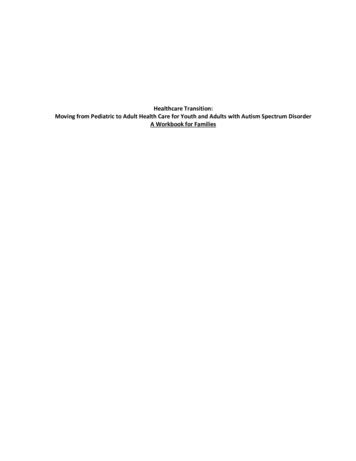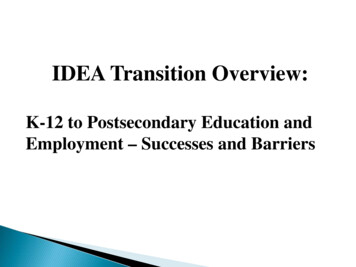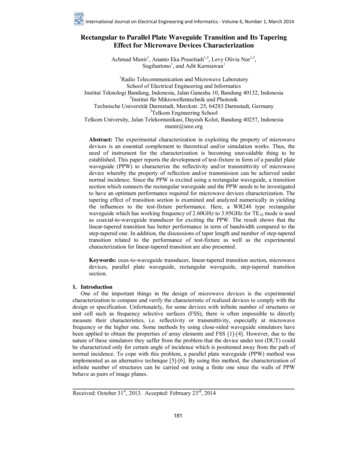
Transcription
betterhighschools.orgLinking Research and Resources for Better High SchoolsEasing the Transition toHigh School: Researchand Best PracticesDesigned to SupportHigh School Learning
betterhighschools.orgThese materials are offered by the National High School Center, a centralsource of information and expertise on high school improvement issuesthat does not endorse any interventions or conduct field studies. Fundedby the U.S. Department of Education, the National High School Centerserves the Regional Comprehensive Centers in their work to build thecapacity of states across the nation to effectively implement the goals ofNo Child Left Behind relating to high schools. The National High SchoolCenter is housed at the American Institutes for Research and partners withother leading education research organizations such as Learning PointAssociates, MDRC, WestEd, and the National Center for EducationalAccountability (NCEA), the organization responsible for the primaryauthorship of this report. The contents of this report were developed under agrant from the U.S. Department of Education. However, those contents do notnecessarily represent the policy of the U.S. Department of Education, and youshould not assume endorsement by the Federal Government.
betterhighschools.orgEasing the Transition toHigh School: Researchand Best PracticesDesigned to SupportHigh School LearningP R E PA R E D B Y T H E N AT I O N A LHIGH SCHOOL CENTERREPORT EDITORSLouise KennellyMaggie MonradNational High School Center at the American Institutes for Research
EASING THE TRANSITION TO HIGH SCHOOL: RESEARCH AND BEST PRACTICES DESIGNED TO SUPPORT HIGH SCHOOL iiThe First Year of High School: A Quick Stats Fact Sheetby Elizabeth Williams and Scott Richman, AIR .1Policy Brief: State and District-Level Support for Successful Transitions Into High Schoolby Corinne Herlihy, MDRC.5Snapshot: Managing the Transition to Ninth Grade in a Comprehensive Urban High Schoolby Thomas J. Smith, MDRC.31iC ONTENTSIssue Brief: Toward Ensuring a Smooth Transition Into High Schoolby Corinne Herlihy, MDRC.17
EASING THE TRANSITION TO HIGH SCHOOL: RESEARCH AND BEST PRACTICES DESIGNED TO SUPPORT HIGH SCHOOL I N T RO D U C T I O N TO N AT I O N A L H I G H S C H O O L C E N T E RRESOURCES ON THE TRANSITION INTO HIGH SCHOOLI NTRODUCTIONThe transition from middle school to high school represents a significant event in the lives of adolescents,one that necessitates support from and collaboration among teachers, parents, counselors, and administrators at both educational levels. Successful transitions place particular emphasis on ninth-grade initiativesand can create one of strongest bridges from middle to high school and beyond. This toolkit contains fourresources—a fact sheet, policy brief, research brief, and snapshot—on how to support and guide a smoothtransition into high school: The First Year of High School, a quick stats fact sheet on the ninth grade bulge, demonstrates that adisproportionate number of ninth graders are held back in the ninth grade, many of whom drop outby tenth grade. State and District-Level Support for Successful Transitions Into High School, a policy brief, examines howsome states and districts are easing the transition to ninth grade. Toward Ensuring a Smooth Transition Into High School, an issue brief, offers a best practices brief basedon key research in the field of ninth grade transitions. Managing the Transition to High School in a Comprehensive Urban Environment provides a snapshot ofhow one schools is managing to make a positive difference for ninth graders.ii
The First Year of High School:A Quick Stats Fact Sheet
EASING THE TRANSITION TO HIGH SCHOOL: RESEARCH AND BEST PRACTICES DESIGNED TO SUPPORT HIGH SCHOOL LEARNINGbetterhighschools.orgQ UICK S TATS F ACT S HEETbetterhighschools.orgThe First Year of High School: A Quick Stats Fact Sheetby Elizabeth Williams and Scott Richman, AIRStudents’ experiences in their first year of high school often determine their success throughout high school andbeyond. However, more students fail ninth grade than any other grade.Students who are promoted to tenth grade, but who are off track—as indicated by failed grades, a lack of coursecredits or a lack of attendance during their ninth-grade gateway year—may have already missed the opportunity toget on a graduation track.S TAT I S T I C SThe following statistics highlight a noticeable trend in the lack of progress of many students throughout freshmanyear. Many students are held back in ninth grade—creating what is known as the ninth grade bulge—and drop out bytenth grade—contributing to the tenth grade dip. Students in ninth grade comprise the highest percentage of the overall high school population because studentsin disproportionate numbers are failing to be promoted out of ninth grade. Promotion rates between ninth andtenth grade are much lower than rates between other grades (Wheelock & Miao, 2005).Student Enrollment by Grade and Percentage of Total Enrollment, 0.5%18.4%16.9%100.0%(Gray, Sable, & Sietsema, 2006) The ninth grade bulge is illustrated by the following numbers: enrollment figures show 4.19 million studentsenrolled in grade nine during the 2003–2004 school year, while figures for the following school year,2004–2005, show enrollment numbers for tenth grade at around 3.75 million—a loss of 10.5% (NCES, 2005).The dip in the number of students in tenth grade reflects both the large number of students not promoted totenth grade as well as those students that drop out after ninth grade and before tenth grade. In the last 30 years, the bulge of students in grade nine has more than tripled, from approximately 4% to 13%(Haney et al., 2004). Researchers at Johns Hopkins University found that up to 40% of ninth grade students in cities with the highestdropout rates repeat the ninth grade, but only 10–15% of those repeaters go on to graduate (Balfanz & Letgers,2004). Ninth grade attrition is far more pronounced in urban, high-poverty schools: 40% of dropouts in low-incomehigh schools left after ninth grade, compared to 27% in low poverty districts (EPE Research Center, 2006). Racial disparities highlight the ninth grade bulge and tenth grade dip—these figures are the most pronouncedfor African American and Latino students. For example, grade nine enrollment is 23–27% higher than grade2
EASING THE TRANSITION TO HIGH SCHOOL: RESEARCH AND BEST PRACTICES DESIGNED TO SUPPORT HIGH SCHOOL LEARNINGeight, and attrition between grades nine and ten hovers around 20% for African American students; for theirwhite peers, grade nine enrollment is 6–8% higher than grade eight, while attrition between grades nine and tenis stable around 7% (Wheelock & Miao, 2005). Twenty-nine of 51 states see their greatest “leakage” in the “education pipeline” occur during the ninth grade(EPE Research Center, 2006). Some states have as high as a 20% decrease in enrollment between ninth andtenth grades (Wheelock and Miao, 2005). Most high school dropouts fail at least 25% of their ninth grade courses, while 8% of high school completersexperienced the same difficulty (Letgers & Kerr, 2001). More than one semester “F” in core subjects and fewer than five full course credits by the end of freshman yearare key indicators that a student is not on track to graduate (Allensworth & Easton, 2005). Low attendance during the first 30 days of the ninth grade year is a stronger indicator that a student will drop out than any othereighth grade predictor, including test scores, other academic achievement, and age (Jerald, 2006).S T R AT E G I E SBecause the research is clear that the first year of high school is pivotal, but the transition into high school is oftencharacterized as a time when students experience a decline in grades and attendance (Barone, Aguirre-Deandreis, &Trickett, 1991), school systems must support first year high school students to improve their chances of success. One strategy to address the challenges facing freshmen is the creation of ninth grade academies that are apartfrom the rest of the high school or the creation of separate stand alone schools (Reents, 2002). One hundredfifty-four ninth-grade-only schools were operating during the 2004-2005 school year (NCES, Common Core ofData).1 In schools in which transition programs are fully operational, researchers saw a dropout rate of 8%, whileschools without transition programs averaged 24% (Reents, 2002). Student self-reports indicate that more transition support that would ease their transition to high school couldhelp. Compared to their perceptions reported the previous year, ninth graders perceive less support and monitoring from teachers and principals and generally like school less than they did in middle school. On average, ninthgraders report being less involved in school activities and perceive the need for more school organization. Theyalso indicate lower self-esteem and higher rates of depression than middle school students (Barber & Olsen,2004).Many research-based practices and policies are available to states, districts, and schools committed to supportingand guiding smooth transitions into high school. Resources and strategies include aligned standards and curriculum, team teaching, catch-up coursework in the first semester using the double block schedule, student advisories,at-risk benchmarks, academic benchmarks, and adolescent literacy initiatives.END NOTE1This statistic reflects the total number of public schools operating in the United States that offered only the ninthgrade, but is not necessarily reflective of the total number of “ninth grade academies.”3Q UICK S TATS F ACT S HEETbetterhighschools.org
EASING THE TRANSITION TO HIGH SCHOOL: RESEARCH AND BEST PRACTICES DESIGNED TO SUPPORT HIGH SCHOOL LEARNINGbetterhighschools.orgQ UICK S TATS F ACT S HEETbetterhighschools.orgREFERENCESAllensworth, E. M. & Easton, J. Q. (2005). The on-track indicator as a predictor of high school graduation, Chicago:Consortium on Chicago school research. Retrieved March 9, 2007 from nz, R., & Letgers, N. (2004). Locating the dropout crisis: Which high schools produce the nation’s dropouts, whereare they located, who attends them? Baltimore, MD: Center for Research on the Education of Students PlacedAt-Risk, Johns Hopkins University. Retrieved March 9, 2007 Crisis Commentary.pdfBarber, B. K., & Olsen, J. A. (2004). Assessing the transitions to middle and high school. Journal of Adolescent Research19(3). Retrieved March 9, 2007 from Barone, C., Aguirre-Deandreis, A. I., & Trickett, E. J. (1991). Means—ends problem-solving skills, life stress, andsocial support as mediators of adjustment in the normative transition to high school. American Journal ofCommunity Psychology 19(2), 207–225.EPE Research Center. (2006, June 22). Diplomas count: An essential guide to graduation rates and policies. EdWeek.Retrieved March 9, 2007 from Gray, D., Sable, J., & Sietsema, J. (2006). Documentation for the common core of data state nonfiscal survey of publicelementary/secondary education: School year 2004–05 (NCES 2006-441). Washington, DC: National Center forEducation Statistics, U.S. Department of Education.Haney, W., et al. (2004). The education pipeline in the United States 1970–2000. Chestnut Hill, MA: The NationalBoard on Educational Testing and Public Policy. Retrieved March 9, 2007 br3.pdfJerald, C. D. (2006). Identifying potential dropouts: Key lessons for building an early warning data system—A dualagenda of high standards and high graduation rates. Washington, DC: Achieve, Inc. Retrieved March 9, 2007 fromhttp://www.achieve.org/files/FINAL-dropouts 0.pdfLetgers, N., & Kerr, K. (2001). Easing the transition to high school: An investigation of reform practices to promote ninthgrade success. Baltimore, MD: Center for Social Organization of Schools, Johns Hopkins University. RetrievedMarch 9, 2007 from /dropouts/legters.pdfNational Center for Educational Statistics. (2005). Digest of education statistics tables and figures 2004. Washington,DC: Author. Available online at http://nces.ed.gov/programs/digest/d05/tables/dt05 097.aspNational Center for Education Statistics: Common Core of Data. (n.d.). Retrieved March 9, 2007 fromhttp://nces.ed.gov/ccd/bat/result.asp?saved 3357Reents, J. N. (2002). Isolating 9th graders: Separate schools ease the academic and social transition for high-schoolbound students. The School Administrator. Retrieved March 9, 2007 il.cfm?ItemNumber 2668Wheelock, A., & Miao, J. (2005). The ninth grade bottleneck. The School Administrator. Retrieved March 9, 2007 il.cfm?mnitemnumber &tnitemnumber &itemnumber 988&unitemnumber &pf 1&snitemnumber 4
Policy Brief:State and District-Level Supportfor Successful Transitions IntoHigh School
EASING THE TRANSITION TO HIGH SCHOOL: RESEARCH AND BEST PRACTICES DESIGNED TO SUPPORT HIGH SCHOOL State and District-Level Support for Successful Transitions Into High Schoolby Corinne Herlihy, MDRCP OLICY B RIEFINTRODUCTIONThe transition into high school is a critical point in the educational pipeline, and ninth-grade can be characterized asone of its leakiest junctures. MDRC’s research in four urban districts suggests that as many as 40 percent of studentsfail to get promoted from ninth- to 10th-grade on time, and fewer than 20 percent of those students recover fromfailure and go on to graduate (Kemple, Herlihy, & Smith, 2005). Nationally, a recent study of public school enrollment patterns shows that (1) there is a sharp increase in the number of students enrolled in ninth-grade over the last30 years, indicating that an increasing number of students are being retained, and (2) the rate at which students disappear between ninth- and 10th-grade has tripled over the same time period (Haney, 2004).Clearly, the transition into high school is difficult for many students. However, it is usually the end result of unsuccessful transitions—high dropout rates, low on-time graduation rates, and low achievement—that receive the mostattention. This policy brief focuses on five key challenges that states, districts and schools should address to support asuccessful transition into high school, particularly for students who are at high risk of failure: Establish a data and monitoring system that will both diagnose why students are struggling and be used to holdschools and districts accountable; Address the instructional needs of students who enter high school unprepared for rigorous, college preparatorywork; Personalize the learning environment to lower the sense of anonymity and address individual needs; Build capacity within the faculty and school leadership in low-performing schools to address diverse studentneeds; and Create connections to the community, employers, and institutes of higher education to better engage studentsand help them see the relevance of their coursework.Examples of the ways in which states and districts have addressed each of these challenges are highlighted throughoutthe brief. These examples do not represent a full survey of such initiatives, and it should also be noted that most havenot been rigorously evaluated for effectiveness. In fact, research on the high school transition is limited; however, thepolicies and practices featured below are all consistent with programs that do have evidence of effectiveness at theschool level.THE CONTEXTIn the last five years, educators and policymakers—including federal agencies, governors, and foundation and business leaders—have recommitted themselves to addressing the challenge of reforming secondary education, particularly low-performing schools. The No Child Left Behind (NCLB) Act of 2001 placed a new focus on K–12 studentachievement. Graduation rates and measures of high school student proficiency in reading and math are factored intostate-defined standards for “adequate yearly progress” under NCLB. The upcoming reauthorization of NCLB promises to put even greater focus on high schools. While launching the new priorities for NCLB this month, U.S.Secretary of Education Margaret Spellings stated, “The national consensus for high school reform has never beenstronger” (U.S. Department of Education, 2007).6
EASING THE TRANSITION TO HIGH SCHOOL: RESEARCH AND BEST PRACTICES DESIGNED TO SUPPORT HIGH SCHOOL LEARNINGbetterhighschools.orgKEY CHALLENGES AND POLICIESChallenge 1: Establish Monitoring and Accountability SystemsThere are few systematic measures of the challenges associated with transitioning into high school. State-reporteddropout statistics are often unreliable, and most states do not regularly report grade-retention data (Haney, 2004).While many states have begun to adopt common methodologies for measuring graduation rates, few states, districts,or even schools have developed monitoring systems that will identify students who are “off track” early in their highschool careers—or better yet, identify those whose performance in middle school indicates high risk for schooldropout. Below are examples of several promising initiatives at the state and district levels.State Initiatives Statewide Longitudinal Data SystemsStates that create longitudinal data systems can develop the information needed to diagnose transition problems and hold schools and districts accountable for student outcomes related to the transition into highschool—for example, on-time promotion and course credit attainment. The Data Quality Campaign(www.dataqualitycampaign.org), a national collaborative, has developed guidelines for states that will help createsystem that can answer questions like “What achievement levels in middle school indicate that a student is ontrack to succeed in rigorous courses in high school?” While only five states currently report having data systemscapable of answering this question, 42 states report the creation of unique student identifiers (an integral part ofa longitudinal data system that tracks students over time), and 26 states indicate that they have or are workingon building data warehouses1. Florida’s data warehouse is considered the most extensive in the country. TheFlorida K–20 Education Data Warehouse provides stakeholders in public education with the capability to receivetimely, efficient, consistent responses to inquiries into Florida’s kindergarten through university education. IndianaIn Indiana, House Bill 1347, enacted by the 2006 legislature, requires that high schools report annually thenumber of freshmen not earning enough credits to become sophomores—a first step toward identifying those athighest risk of dropping out, which is critical for planning focused dropout prevention activities.District InitiativesSchool districts in Chicago and Philadelphia are using similar data to identify students who need extra support andare developing interventions to get them back on track for graduation: Chicago Public Schools and the Consortium on Chicago School ResearchChicago Public Schools (CPS) have integrated a ninth-grade “on-track” indicator into their accountability system in an effort to help high schools focus on students in need of intervention. The indicator, developed byresearchers at the Chicago Consortium on School Research, uses students’ class credits and failures as predictorsof their probability of graduating on time. For example, a freshman student must pass five full-year courses andreceive no more than one “F” in order to be deemed “on track.” It has been relatively easy for schools to use the7P OLICY B RIEFA substantial review of the research literature documents the fact that the transition into high school is marked byincreased disengagement and declining motivation among students, which in turn, predict subsequent school failureand dropout (Kemple et al., 2005). Unfortunately, few rigorous studies provide evidence to support students at thiscritical time. Still, many schools, districts and states have developed programs and policies to address the challengesfaced by students transitioning into high school.
EASING THE TRANSITION TO HIGH SCHOOL: RESEARCH AND BEST PRACTICES DESIGNED TO SUPPORT HIGH SCHOOL indicator, since information regarding students’ course credits is readily available within schools. TheConsortium reports that use of the “on-track” indicator in CPS has been successful: “from the 1994–1995 to2003–2004 school years, on-track rates have increased 10 percentage points, from 48 to 58 percent of studentson track” (Allensworth & Easton, 2005).P OLICY B RIEF School District of Philadelphia and the Philadelphia Education FundA study produced by the Philadelphia Education Fund (PEF), which followed sixth-graders in the SchoolDistrict of Philadelphia for seven years (from the 1996–1997 to 2003–2004 school years), identified four factorsthat were strong predictors of student becoming off track in high school—low attendance, poor behavior marks,failing math, and failing English. When a sixth-grader exhibited even one of these factors, his or her chance ofgraduating from high school on time decreased severely. Based on the findings, PEF has awarded “InnovationContinuation Grants” to nine middle-grade schools in Philadelphia to reduce these risk factors in their students.Researchers will monitor student outcomes to gauge the success of these grants, which will then assist schools todevelop effective means of targeting their at-risk students (Herzog & Balfanz, 2006).Challenge 2: Address Diverse Instructional Needs of Incoming High School StudentsRigor is one of the “new three R’s” of recent high school reform efforts—rigor, relevance and relationships. Acrossstates, the push for more rigorous coursework, higher graduation requirements, and graduation exams has generatedconcern for students who enter high school poorly prepared for college prep courses. And, there is good reason to beconcerned. Nationally, fewer than 30 percent of eighth-graders scored proficient on the 2005 NAEP mathematics orreading tests (Education Week, 2007). Even when achievement is measured by local standards, most states have atleast one-quarter of their students entering high schools with scores below proficient in math and/or reading oneighth-grade assessments (Education Week, 2006). In addition, there is great variation within states and even withindistricts. For example, in Philadelphia, only the city’s magnet high schools had 80 percent or more of their incomingninth-graders reading and doing math at a seventh-grade level. In contrast, the majority of its neighborhood highschools had entering freshmen classes in which less than one-third of the students did as well on both math and reading (Neild & Balfanz, 2001).High schools must meet the diverse needs of students, many of whom need extra support to get caught up to at leastgrade level in reading and math. Traditional remedial classes do not work if they are not designed to “accelerate” learning, so students are ready to do college prep work early in their high school careers. Otherwise, students do not haveenough time to get caught up and end up frustrated by their poor preparation and disengaged by remedial content.State Initiatives Virginia’s Algebra Readiness InitiativeThe state of Virginia authorized funding in 2001 to provide matching funds to districts to conduct interventionsfor students in grades six to nine who are at risk of failing the state’s algebra exam at the end of ninth-grade.Students within participating districts are identified through a computer-adaptive diagnostic test, which the statehas made available to all school districts. The intervention includes 2½ additional hours of services per week anda 10-to-1 student-to-teacher ratio for each program. Apart from these requirements, each district may decide onits own intervention model and whether it meets afterschool, before school, or in the summer. The state fundingalso requires that a posttest be given which will allow the state to track the students’ gains and research theeffects of the incentive funding.8
EASING THE TRANSITION TO HIGH SCHOOL: RESEARCH AND BEST PRACTICES DESIGNED TO SUPPORT HIGH SCHOOL LEARNINGbetterhighschools.org Talent Development’s specialized curricula in districts across the countryDistricts and schools across the country are implementing the Talent Development High School (TDHS) model(Kemple, Herlihy, & Smith, 2005). The academic centerpiece of the TDHS is the combination of extendedblock scheduling, double-dosing of key subjects, and specialized curricula in ninth-grade. The TalentDevelopment curriculum was designed to let students catch up from low performance levels commonly foundwhen they entered high school in the ninth-grade—two or more years below grade expectancy. During the firstsemester, ninth-grade students take two “catch-up courses”—Transition to Advanced Mathematics and StrategicReading. These courses are designed to enhance the skills of incoming freshmen and enable them to succeed intraditional ninth-grade algebra and English in the second semester. Additionally, ninth-grade students take athird Talent Development course, called Freshman Seminar, which combines study skills, personal goal-setting,and social group skills designed to prepare students more broadly for the demands of high school. A rigorousstudy of TDHS in five Philadelphia high schools found that it produced substantial gains in attendance, academic course credits earned (especially in algebra), and promotion rates during students’ first year of high school(Kemple, Herlihy, & Smith, 2005). Districts implementing this approach include Kansas City, MO; Chicago,IL; and Chattanooga, TN.Challenge 3: Personalize the Learning EnvironmentHigh schools are typically larger and more bureaucratic than elementary and middle schools, leading to depersonalization and a noncommunal climate (Lee & Smith, 2001). In a recent survey of young people who left high schoolwithout graduating, nearly half (47 percent) reported being bored or disengaged from high school. Thirty-eight percent believed that they had “too much freedom” and not enough rules (Bridgeland et al., 2006). It is easy for ninthgraders to get lost in the shuffle, skip school without consequence, or quietly fail without any concerted interventionby the school. There are many examples of interventions designed to personalize the high school environment. Someare structural, such as creating small learning communities or small schools; and some programs increase opportunities for adult/student interactions, making adults responsible for individual students who might otherwise fallthrough the cracks.State Initiatives Georgia’s Graduation Coaches—An Approach to PersonalizationAs part of a 1 billion increase in Georgia’s investment in education, the state has implemented an initiative thatputs a graduation coach in every public high school. These coaches work with students in grades eight to 12 whomthey deem at risk of dropping out of high school and connect them with outside agencies and programs, if necessary. For example, graduation coaches link students with community mentors, create individualized graduationplans for students, and develop credit-recovery programs. Graduation coaches are trained by a partnershipbetween a national organization, Communities in Schools, and the Georgia Department of Education, to identify at-risk students, to understand the landscape of community and school organizations, and to use differenttechniques to target their student population (e.g., case management, group activities, etc.).District Initiatives Small Learning CommunitiesSmall learning communities (SLCs) are a way to organize high schools into smaller units. Generally, an SLCincludes an interdisciplinary team of teachers who share a few hundred or fewer students in common for instruction. Teachers assume responsibility for the educational progress of students in their SLC across several years of9P OLICY B RIEFDistrict Initiatives
EASING THE TRANSITION TO HIGH SCHOOL: RESEARCH AND BEST PRACTICES DESIGNED TO SUPPORT HIGH SCHOOL P OLICY B RIEFschool, working together to meet the needs of each student. SLCs have emerged as one of the most commonand potentially effective school reform strategies. They are a key component of several comprehensive schoolreform models—including Talent Development, which includes an independent SLC for freshmen that feedsinto upper-grade career academies; and First Things First, which establishes four-year thematic SLCs. Researchhas shown that SLCs may enhance student engagement and success in school, serving as a platform for supporting other needed instructional and curricular reforms (Kemple, Connell, Klem, Legters, & Eccles,
lum, team teaching, catch-up coursework in the first semester using the double block schedule, student advisories, at-risk benchmarks, academic benchmarks, and adolescent literacy initiatives. END NOTE 1 This statistic reflects the total number of public schools operating in the United States that offered only the ninth










